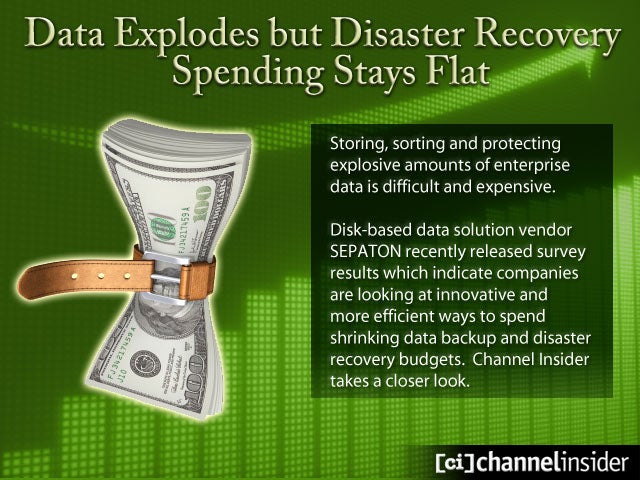 Data Explodes but Disaster Recovery Spending Stays Flat
Data Explodes but Disaster Recovery Spending Stays Flat
 No Title
No Title
SEPATON’s survey focuses on defining and quantifying data protection needs, business objectives and tech requirements for data centers through 2010. Interviewed were almost 450 companies with more than 1,000 employees and at least 50 terabytes of data. Respondents come from a wide array of industries, including financial services, healthcare and energy and utilities.
 No Title
No Title
Data is growing at an exponential rate – and companies in industries like healthcare are getting the worst of it. 47% of survey respondents have more than 200 terabytes of data to protect, and 57% say their data stores are growing at more than a 20% Compound Annual Growth Rate.
 No Title
No Title
Companies are worried about their data and 70% cite improving disaster recovery protection as their number one goal in 2010. 46% admit failure in meeting recovery times and recovery point objectives in a consistent manner.
 No Title
No Title
Everyone is suffering in the economic downturn, but even exponential data growth and growing compliance concerns does not translate into budget allocation. 73% of enterprises say data protection budgets will either stay the same or decrease in 2010. Still, improving disaster recovery activities and keeping abreast of data center growth is among the enterprise’s top priorities.
 No Title
No Title
Backing up to tape has its advantages. It’s cheap and the infrastructure already exists. But, tapes often don’t last and come with a wide array of drawbacks. Survey respondents say a key focus of 2010’s spending will be focused on disk-based technologies that increase levels of protection and reduce total cost of ownership.
 No Title
No Title
Most enterprises are still using tape today, but more than 60% plan to reduce or eliminate the use of tape altogether next year. To improve management and reduce costs, businesses are looking at disk-to-disk back-up, Virtual Tape Libraries (VTL) and moving disaster recovery and cloud backup to MSPs powered with software from vendors like Asigra.
 No Title
No Title
41% of respondents say insufficient budgets are the chief reason data protection strategies fall short. Respondents also indicate that the lack of new equipment is stalling their efforts to maintain service levels and meet regulatory compliance objectives.
 No Title
No Title
Completing a full backup takes more than 24 hours for 43% of SEPATON’s survey respondents, and 11% of enterprises needed more than 20 full-time employees to manage their data protection. That means time and labor costs are sky-high for corporations looking to reduce data protection budgets.

